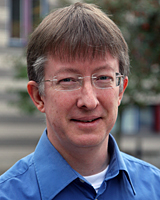Tough nut that can withstand 600 degrees heat
Large grant for hot electronics
Fatal radiation, 600 degrees heat and a really exciting existence of several kilovolts. That's what KTH researchers' electronics have to cope with when they are used in such brutal environments such as in nuclear power plants and on oil rigs. SEK 24.2 million in research grants will help scientists to succeed.

"This research is interesting because we get to test the electronics in really tough conditions." These are the words of Carl-Mikael Zetterling, professor of solid state electronics at KTH.
Together with, among others, KTH Professor Mikael Östling, Anders Hallén, and Professor Hans Norström from the Ångström Laboratory at Uppsala University, he has received over SEK 24 million to research HOTSiC. They will now be developing the electronics that can be used in outer space, for oil and gas drilling, in cars and aircraft, industrial engines and nuclear power plants.
"We will be developing working prototypes. It is about integrated circuits of silicon carbide that can be used, among other things, for sensors that measure pressure and temperature. Silicon carbide is used because the material is 100 times more resistant to radiation than silicon," says Carl-Mikael Zetterling.
But it's not just radiation which SiC is resistant to. The material is also capable of withstanding large thermal variations and high voltages.
Carl-Mikael Zetterling continues by adding that the reason behind this research is that they want to develop complete systems that can be placed in these tough environments. Today they mainly have sensors in these sorts of environments. The rest of the electronics, the system itself, is placed in a protected environment.
"If there is a long conduit between the sensor and system, the signal becomes weak and difficult to interpret. We want to put all the electronics in the same place, it will produce a more reliable system when we receive strong signals to analyze," says Carl-Mikael Zetterling.
Putting everything in one place also means that the energy loss can be reduced significantly.
"If we can place the transistors directly on the motor, without adding a cooling system, we stand to gain a lot. A cooling system steals energy and also means lots of extra unnecessary weight," says Carl-Mikael Zetterling.
He adds that talks are underway with KTH Professor Janne Wallenius to test components on the next generation of nuclear reactors that are metal cooled. Even there electronics can be located closer to the reactor core and still produce reliable system performance.
For more information, contact Carl-Mikael Zetterling at 08-790 43 44 or bellman@kth.se.
Peter Larsson

